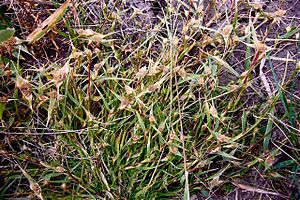Rigid thorn grass
| Rigid thorn grass | ||||||||||||
|---|---|---|---|---|---|---|---|---|---|---|---|---|

Rigid thorn grass ( Crypsis aculeata ) |
||||||||||||
| Systematics | ||||||||||||
|
||||||||||||
| Scientific name | ||||||||||||
| Crypsis aculeata | ||||||||||||
| ( L. ) Aiton |
The Rigid Whitethroat ( Crypsis aculeata , Syn .: Sporobolus aculeatus ) is a species of the genus Dorn grasses ( Crypsis ) and the family of the sweet grasses (Poaceae).
description
Rigid thorn grass is an annual grass that grows in dense clusters that sometimes lie completely on the ground. The stalks are 2–35 centimeters long, they are lying on the ground or kneeling ascending, rarely upright and have 3–12 knots. The nodes are smooth and glabrous. The leaf sheaths are significantly shorter than the limbs and outside on both sides at the transition to the leaf blade with a tuft of 2-3 millimeters long hairs. The uppermost 3–4 leaf sheaths and the side branches are strongly puffed up and surround an inflorescence. The ligule is a thick lash line. The leaf blades are only 1–8 inches long and 1–3 millimeters wide, they are stiff and rigid and protruding. The inflorescence is a spherical head which is 7 millimeters high and 8-12 millimeters wide and which is given a characteristic appearance by the enveloping leaf sheaths and protruding leaf blades. The spikelets are single-flowered, 4–5 millimeters long. The glumes are single-nerved. The lemma is einnervig, 3.6-4.2 mm long and narrow rounded at the upper end. The palea is single-nerved. There are only two stamens available, the anthers are 1–1.2 millimeters long.
The flowering period is July to October.
The chromosome number is 2n = 16 or 18.
distribution
Rigid thorn grass occurs from central and southern Europe to the Sahara and northern Korea. It is absent in Germany and Switzerland and occurs in Austria in Lower Austria and Burgenland.
ecology
Rigid thorn grass often occurs together with foxtail thorn grass ( Crypsis alopecuroides ) in pioneering societies on open, wet or alternately wet, nutrient-rich, salty, more or less humus-rich, sandy or pure clay soils. It is a salt pointer and a species of character of the Heleochloion association from the Isoeto-Nanojuncetea class.
Taxonomy
The rigid thorn grass was first described by Carl von Linné in Sp. Pl .: 42 (1753) as Schoenus aculeatus . The species was made by W. Aiton in Hort. Kew. 1: 48 (1789) placed as Crypsis aculeata in the genus Crypsis . Most recently it was placed by PM Peterson as Sporobolus aculeatus (L.) EM Peterson in Taxon 63: 1234 (2014) in the genus Sporobolus . Synonyms for Crypsis aculeata (L.) Aiton are: Agrostis aculeata (L.) Scop. , Heleochloa diandra host , Phleum aculeatum (L.) Lam. and Antitragus aculeatus (L.) Gaertn.
literature
- Hans Joachim Conert: Crypsis aculeata . In: Gustav Hegi : Illustrated flora of Central Europe . 3rd ed., Volume I, Part 3, pages 101-102. Verlag Paul Parey, Berlin, Hamburg, 1987. ISBN 3-489-52320-2 (description, distribution, ecology)
Individual evidence
- ↑ a b Rafaël Govaerts (Ed.): Sporobolus aculeatus. In: World Checklist of Selected Plant Families (WCSP) - The Board of Trustees of the Royal Botanic Gardens, Kew . Retrieved June 28, 2020.
- ^ Erich Oberdorfer : Plant-sociological excursion flora for Germany and neighboring areas . With the collaboration of Angelika Schwabe and Theo Müller. 8th, heavily revised and expanded edition. Eugen Ulmer, Stuttgart (Hohenheim) 2001, ISBN 3-8001-3131-5 , pp. 239 .

